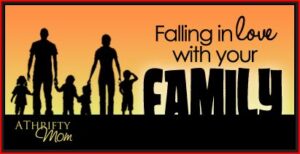Falling in Love with your Family by Alison
In a Nutshell: Help kids use their words by giving them an emotional vocabulary.
I am a bit of a poetry freak, so I was happy to find two sets of magnetic poetry kits at a yard sale. They are tiny magnets covered with random words that stick to the fridge to make new poems. I thought my kids would have fun with them. One was a standard word set, and one contained insulting words from Shakespeare plays to put together kind comments like, “Fie on you, vain, weed-witted knave!” (Hey, it’s all about brotherly love around my place.) We had fun with them for awhile, and then they were put on top of the fridge to gather dust with all the time-out banished toys.
Enter my husband. Sweet guy that he is, he decided to kindle a little romance and write me a poem. I was touched by the effort, but couldn’t help laughing when I found it. I commented to him, “I think you are the only person alive who could write a love poem out of the Shakespearean Insult Poetry Kit.” Yep. He got the wrong set of words. He said that explained why he had such a hard time finding anything nice in there. Sometimes, we know what we want to say, but we just don’t have the right words!
It’s the same with kids. Often tantrums, whining, fighting, and withdrawing happen in families because our inexperienced children just can’t find ways to express what they really want to say. It is a basic need to feel understood. When we don’t feel that way, our feelings often bubble over in inappropriate ways that can damage family relationships. Here are a couple ways to help kids find the right word kit to express how they are feeling:
Label
When you are feeling emotions about something, try labeling them. It may feel awkward at first to say something like, “I’m embarrassed because we are late,” “I’m frustrated because the playroom is messy again,” or “I was so happy when you helped that boy at the park,” but it begins to give kids an emotional vocabulary to build on. I’ve always been pretty delighted when a ticked-off two-year-old would stamp their feet and say, “I so angry at you!” or bury their head in my lap and say, “I’m shy about that.” I know they are beginning to learn the words to let the world know what is going on inside.
When children start behaving badly, parents can help them label what they are feeling instead of just telling them to stop. You can say things like, “Are you mad?” “You seem frustrated that we have to leave now” or “Are you feeling embarrassed because I kissed you in front of your friend?”
Labeling emotions doesn’t mean that kids won’t also get a time-out for hitting, or lose a privilege for refusing to get in the car, but they will begin to build the important skill of saying what they feel.
Play
Little kids usually love playing games with facial expressions. You could make a surprised, excited, upset, or shy face and ask your child to do the same, saying, “Let’s see your happy face!” I also made a circle out of leftover felt, and cut out eyes, nose, mouth, eyebrows, etc. I like to make different expressions and ask, “What are they feeling?” You could do the same with a chalkboard or paper. Either way, it helps make playtime into a time for giving kids the gift of an emotional vocabulary.
Allow strong feelings
Children need to feel that they can express hard things. When parents try to tell kids why they shouldn’t be afraid, why they have no right to be mad, or why they have nothing to cry about, it teaches kids to hide confusing or strong emotions, or to express them in nonproductive ways. It’s no fun to grow up believing that everyone has to be fine all of the time. When parents allow children to feel how they feel, they are more likely to be able to help children deal with strong emotions appropriately. When you say, “Use your words,” they’ll have the emotional vocabulary to truly express how they feel.

Comments are closed.